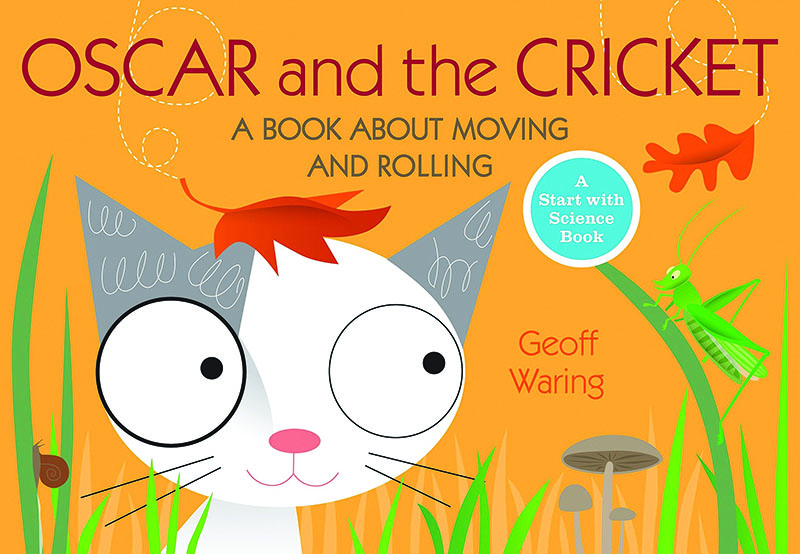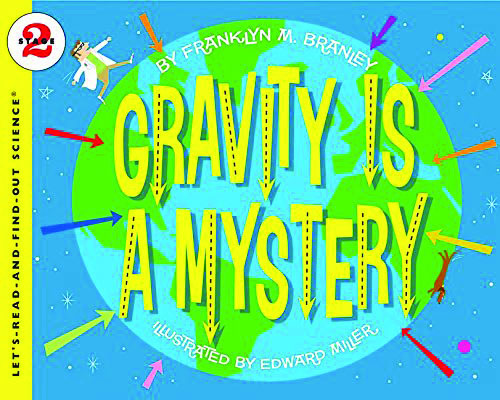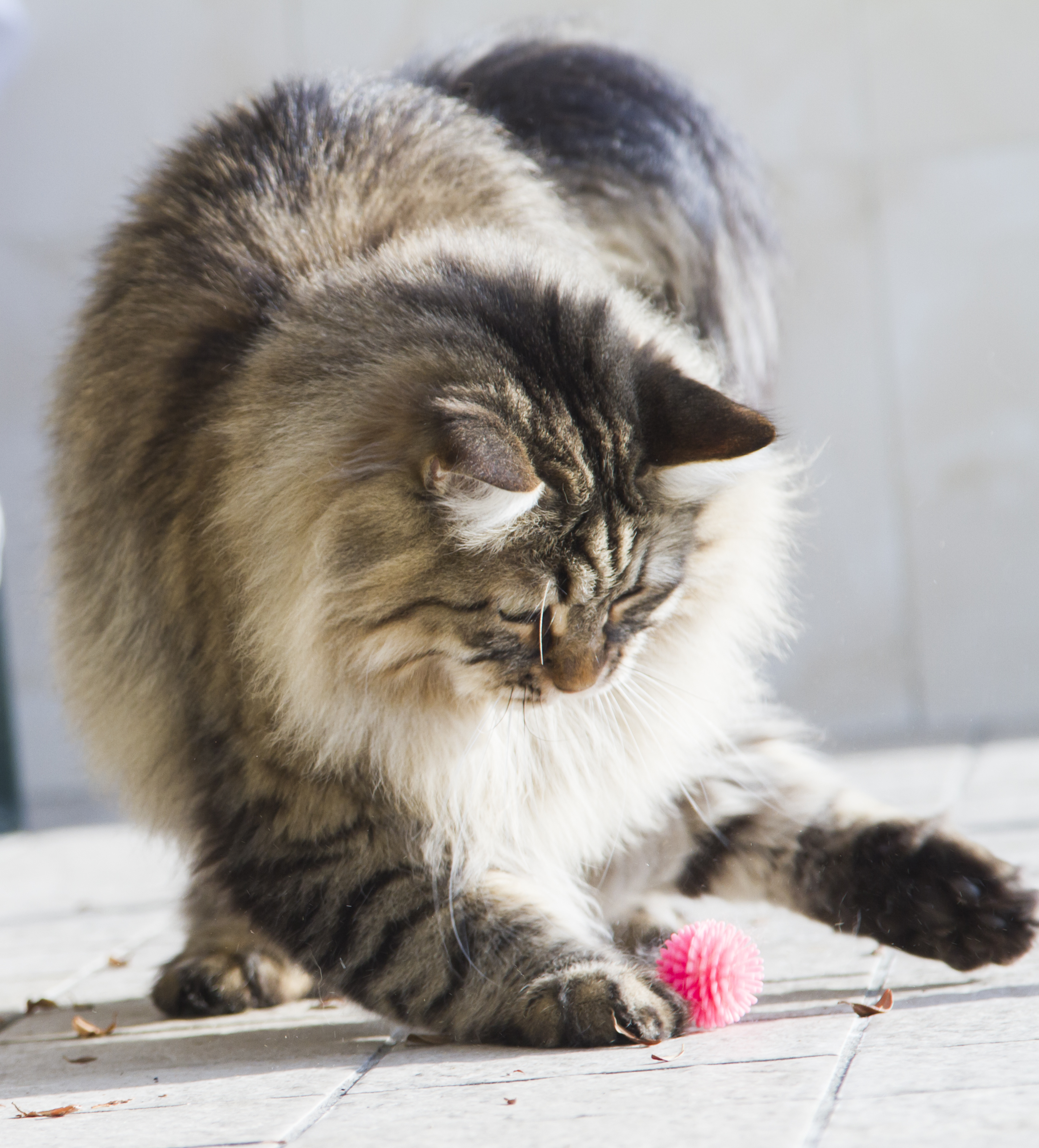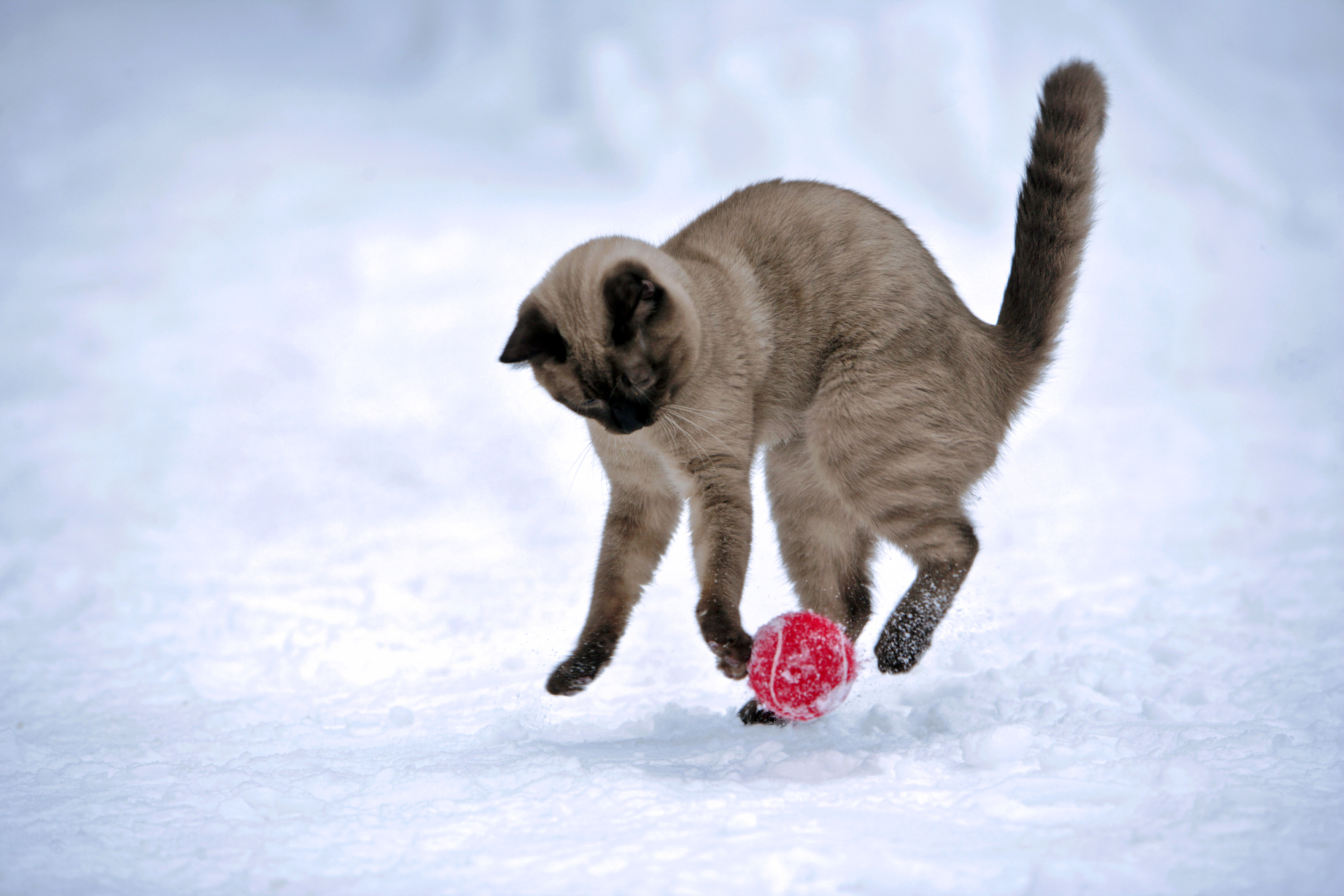Teaching Through Trade Books
Interacting With Forces
By Christine Anne Royce

All around us are opportunities to observe forces and interactions between objects. For younger students, two toy cars crashing into one another may simply be a game, but this activity can also be used to help them understand a key physical science concept. For intermediate students, ideas about how much force needs to be applied to hit a baseball start to make sense. The books selected for this month focus on different types of interactions between objects and ask students to consider what happens when a force is applied to an object. Does it stop? Does it change direction? Which force is stronger? How does gravity affect the object?
This Month’s Trade Books

By Geoff Waring
ISBN: 978-0-7636-4512-0
Candlewick Press
32 pages
Grades preK–3
Synopsis
Oscar the cat finds a ball in the grass and is encouraged by Cricket to experiment by pushing and rolling it. Through trial and error, Oscar finds that the ball moves differently on grass than on a path and that it changes direction when it hits a tree. The book also explores other examples of pushing and pulling objects.

By Franklyn M. Branley
Illustrated by Edward Miller
ISBN: 978-0-06-4452014
HarperCollins
40 pages
Grades 1–4
Synopsis
Students are introduced to the idea that what goes up must come down, as well as the cause of this fact: gravity. The idea that gravity pulls everything toward the center of the Earth is examined through investigations conducted by the characters in the story.
Grades K–2: How Does It Move?
Purpose
To describe how a push or a pull is a force and that different forces affect an object’s motion and direction.
- Oscar and the Cricket: A Book About Rolling and Moving
- red rubber ball
- painter’s tape
- rubber balls or kickballs (same type for all students)
- plastic scooter boards
- rope
- books
- Event Record Sheet (see NSTA Connection)
- Decision Signs (see NSTA Connection)
- Push/Pull Sorting Cards (see Internet Resources)
Engage
Show students the cover of Oscar and the Cricket: A Book About Moving and Rolling and start a discussion about how things move. Ask students, “If you had a ball, how or when would it start to roll?” Accept all student ideas initially. Then, read the story to students and focus on the following key points:
- p. 7: Oscar finds a red ball. Hold up a red rubber ball and ask students to consider what Cricket said: “You can make it roll. Try pushing it with your paw.” Ask students, “What do you think will happen if we push the ball gently? With more force?”
- pp. 8 and 9: Ask students, “Why do you think the thick grass slowed the ball down? What do you think will happen if Oscar rolls the ball on the path?”
- pp. 10 and 11: Ask students, “When Oscar tried to move the branch, Cricket suggested giving it a good pull to move it. Describe in your own words what it means to pull something.”
- pp. 12–15: Ask students, “What are some of the forces that the ball encountered as Oscar tried to make it move? What happened when the ball hit the tree? What would have happened if the ball didn’t hit the tree?”
- pp. 18 and 19: Ask students, “What are ways that objects can move? What helps people and animals move themselves?”
- pp. 22–25: Ask students, “The ball rolled farther this time. What was the reason that Cricket gave to Oscar for this? What finally stopped the ball? What would have happened if Ted hadn’t stopped it with his paw?”
- pp. 28 and 29: Discuss each idea presented with students and ask them to use their own words and explanations to define <i>push</i> and <i>pull</i>.
Explore
Teacher setup note: Before starting this activity, place three strips of painter’s tape on the floor approximately one foot apart to serve as the target lines for this activity. To make the third event easier, place the third strip of tape (the one farthest from students) approximately two feet away from a wall or low obstacle such as a board. Also place painter’s tape on the floor as a start line. Divide students into partners and take them to a multipurpose room, a gymnasium, or a wide hallway where multiple students will be able to roll balls on a smooth surface. Model for students what they will be aiming for within the target area during the push and pull events.
Event 1: Pushing
Using the same type of ball, such as a small rubber one similar to what Oscar used or even kickballs, ask the pairs of students to sit behind the starting line and place their ball on the starting line. Explain to them that their task is to use force to get the ball to stop between the first and second line of painter’s tape. Have them discuss with their partner what they know about pushing as a force and then allow each student to push the ball so that it rolls forward and stops. Tell students to think about how they push the ball and how hard they push the ball this first time. Allow each student to try to hit the target.
Using painter’s tape, mark the spots where each student’s ball came to rest with his or her name. Ask students to make observations about how far their ball rolled, in which direction it rolled (e.g., did it roll straight ahead?), and compare to their partner’s roll. Questions to ask include, “Which roll went farther, yours or your partner’s?” and “Did the ball stop before the target area, in the target area, or after the target area?” Ask students to return to the starting line and make comparison statements between their roll and their partner’s on their Event Record Sheet (see NSTA Connection). Have them determine what they need to do to hit the target on their second attempt.
Ask them to repeat the process of pushing the ball so that it rolls forward. Then ask students to return to their Event Record Sheet and record their observations for the second roll.

Event 2: Pulling
Locate several books that weigh about 10 pounds, tape them onto plastic scooter boards from your school’s physical education department, and tie a rope to one of the handles. This will allow students to pull the board forward so that it moves and maintains the same amount of weight. Ask students to consider whether they should use a push or a pull to move the scooter with the books. Their constraints are that they must use the rope and cannot touch the scooter. Ask them to discuss with their partner which idea they think would work best and why. Let them test their idea first and then test additional ideas for comparison. Ask them to compare on their Event Record Sheet how pulling the scooter is similar to how Oscar had to pull the tree branch out of the way.

Event 3: Bouncing
Return to the first event setup and add either a low wall made from a 2” × 18” piece of wood or an actual wall. Remind students that in the story, Oscar watched his ball bounce back toward him when it hit the tree. In this event, they are trying to get their ball to roll forward, hit the wall, and then stop in the target area. Model this for students and, depending on where your ball stops, ask students to discuss what might have been done differently, such as rolling the ball with more or less force. Once again, mark the spot where each student’s ball stopped with painter’s tape for comparison and discussion purposes. Allow each team to repeat the process from Event 1 (i.e., trial, recording the outcome, discussion of results, and a second attempt).
Most students will not hit the exact target, which is fine. The point of this Explore activity is for students to consider whether they should use a push or a pull to accomplish an activity and how much force should be applied.
Explain
Involve students in a discussion about their observations and conclusions from the Explore activity. Hang the Decision Signs (see NSTA Connection) in different gathering locations around the classroom. Have students move to a particular area of the room based on their answer to the following questions, so that they are divided into groups for each topic. For the first event, the teacher can say to students:
“How many of you had your ball stop before the target in the first activity? Please go to the side of the room marked ‘before the target.’ Those who had their ball go farther than the target, please find the location in the room marked ‘farther than the target.’ Those who hit the target, please form a group where it says ‘on target.’ Now that you are in your groups, please discuss with each other what happened or how far your ball went. What conclusion did you arrive at based on where the ball stopped? How would you need to change your second attempt?”
Once individual groups of students have discussed their ideas, draw them back into a whole-class discussion to see whether the ideas make sense to everyone.
Have students repeat this process with the next two activities, one at a time. Change the signs to represent the decisions from each. For the second event, the signs are “push the scooter first” and “pull the scooter first.” The signs for the third event are, “ball didn’t hit the wall,” “ball hit the wall and stopped short of the target,” “ball hit the wall and stopped farther than the target,” and “ball hit the wall and stopped in the target.”
Elaborate
The Next Generation Science Standards (NGSS Lead States 2013) website features multiple ideas for activities related to the topic of forces and interactions. One such activity, Push and Pull Sorting Cards (see Internet Resources), asks students to consider a variety of everyday objects and actions that require pushing, pulling, or both to cause the objects to work or move. Hold up one of the cards and pose the following questions to students:
- “What do you see in this picture?”
- “Can you describe what is happening or what the object is?”
- “What two things are interacting?”
- “What force is required for the object to move or work?”
For example, one of the pictures is a person playing the piano. The interaction that happens is between the child and the piano keys when the child pushes down on them to make a sound. Students may also say that the piano keys are pushing up on the person’s fingers, but with a weaker force than the child is pushing down. Depending on students’ age or understanding about how a piano works, they might also say that there is an interaction between the piano’s pedals and the child, or between the strings and hammers.
Ask students, as a whole class (with younger students) or in small groups (with older students), to discuss whether each object can be pushed, pulled, or both to make it work. Ask students to discuss the three labels of “push,” “pull,” and “push and pull” and then sort appropriately. Have students explain their reasoning for placing each card in its category. (Teachers should note that many pictures could be placed in different categories depending on how the object is used or whether students describe more than the most basic actions. Therefore, the need for students to explain their reasoning is important.) Finally, ask students to select one of the objects and illustrate it on their student sheet.
Evaluate
Students make connections to Oscar and Cricket to describe their understanding of pushing and pulling, and how both of these are forces. After using forces to accomplish tasks, students discuss their findings and adapt their actions to using less or more force in second attempts. Finally, they exhibit their understanding of how force is used with daily objects.
Grades 3–5: Identifying Gravity
Purpose
To observe how gravity interacts with different objects and determine that gravity pulls objects toward the center of the Earth.
- Gravity Is a Mystery
- video clips (see Internet Resources)
- Falling for Gravity Student Sheet (see NSTA Connection)
- Informational Poster Sheet (see NSTA Connection)
- Ping-Pong balls
- baseballs
- scale
- sheets of paper
- meterstick
Engage
Pose the following question to students and allow them to discuss their ideas: “When something is dropped or falls from a high place, does it always fall downward?” Once students have discussed their ideas, show them several video clips (see Internet Resources) in the following order and discuss each:
- “Freefall in the Seating of the Spirits Cave” (3:58–5:00): In the first video, Felix Baumgartner jumps into a very deep cave opening. What do you notice about his movement at first? In what direction does he fall? When he opens the parachute, what happens to his movement?
- “World’s Highest Civilian Sky Dive” (entire clip): This video shows someone freefalling from 30,000 feet but didn’t open his parachute until he was almost on the ground. When you watch him falling, in which direction is he moving? How can you tell this from the video?
- “Felix Baumgartner Space Jump” (3:00–13:00): Felix Baumgartner jumped from the edge of space in 2012. Where was Felix when he jumped? During the first few minutes, the video talks about him “falling” toward the Earth. What do you think was causing him to fall toward the Earth? When he opened his parachute, what happened to the speed at which he was falling? Why do you think the speed decreased when the parachute opened?
- “Astronauts on the Moon” (entire clip): This video shows astronauts trying different things on the Moon, from jumping to throwing things to falling. Does it look easier for astronauts to do these things on the Moon than it would be on Earth?
Hopefully at some point during this discussion, students will mention the word gravity. If they do not, introduce the term yourself. Then, ask students whether they can describe what gravity is in their own words.
Explore
Using the activity on page 32 of Gravity Is a Mystery, have students investigate how gravity affects objects of the same and of different shapes. Hold up two different balls, such as a Ping-Pong ball and a baseball, and ask students what they think will happen if the balls are dropped from the same height. Ask them to consider factors that might impact how the objects fall. Their weight is often the first idea that students come up with, so allow them to weigh the balls on a scale and record their information.
Then, give each group of students a set of materials including a Ping-Pong ball, baseball, meterstick, and the Falling for Gravity Student Data Sheet (see NSTA Connection). Let them test the question of what happens to the balls when they are dropped from the same height. Model a technique to help them drop both balls at the same time: They should lay their arms across a desk so that their arms are at the same height and then have a single student serve as the person who counts down to the drop. Next, ask students to drop the Ping-Pong ball and a sheet of paper held flat, and record their results. Finally, ask them to drop the Ping-Pong ball and a sheet of paper crumpled into a ball. At this point, ask students to compare their notes and determine whether they think the weight of an object affects how fast it falls and in what direction. (Teachers note: Each object has weight based on its mass and the interaction of gravity with its mass.) Tell groups to return to their student sheet and draw conclusions about the results of their investigation.
Explain
Read Gravity Is a Mystery to the class in its entirety, and then return to the following points to guide discussion:
- pp. 5–8: In the video where Felix Baumgartner freefell into a deep cave, he eventually stopped. Compare his jump into the cave with the situation that the character describes in the book. Do you think the cave extends past the center of the Earth? Why or why not? Why would the character start to slow down until he comes to a stop each time he moves past the center of the Earth? Where does gravity pull things toward?
- pp. 10 and 11: What do you think would happen if there were no gravity when you threw a ball into the air? If you tried to sit or lie down?
- pp. 16–20: How is gravity related to how much you weigh? Is there gravity on the Moon? Other planets? How do we know?
- pp. 21–27: When you watched the video “Astronauts on the Moon,” you saw that the astronauts on the Moon were able to jump higher than they would on Earth, even while wearing their spacesuits, and throw things further. Do you think there is a stronger pull of gravity on the Earth or the Moon? Why? Compare Earth’s gravity to that of other planets.
Elaborate
Tell students that they have been hired by NASA to create informational posters on gravity for other schools. Ask students to use the Informational Poster Sheet (see NSTA Connection) to create a poster that explains gravity in their own words, includes a picture that represents gravity’s effect on objects and people, and highlights two benefits that exist because of gravity.
Evaluate
Gravity is an elusive concept for students; however, in this set of investigations, students make connections between gravity and falling objects. Students then test how gravity affects objects.


